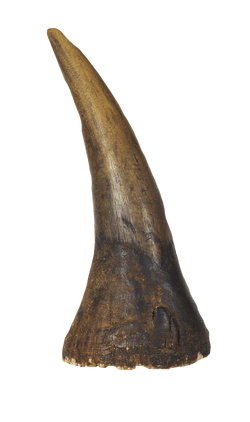| Albrecht Dürer's Rhinoceros Horn | |
|---|---|

| |
|
Origin |
Albrecht Dürer |
|
Type |
Rhinoceros Horn |
|
Effects |
Owning and/or touching horn slowly transforms biological organisms into a living breathing rhinoceros |
|
Downsides |
Effects |
|
Activation |
Touch |
|
Collected by |
|
|
Section |
|
|
Aisle |
3094-4358 |
|
Shelf |
298-4583289-425 |
|
Date of Collection |
Unknown; Era of Warehouse 10 |
| [Source] | |
Origin[]
Once belonging to a Indian Rhinoceros that was the model for a sketch that Albrecht found, along with a Horn of the beast. Along with the sketch, the horn helped him draw out the sketch of a Rhinoceros, although it wasn't a accurate sketch, it was the only one that people had to work with, because at the time the only Rhino that was seen by Europeans was during the reign of the Roman Empire. The Horn was imbued with Albrecht's description and detail, then eventually it was given the power to metamorphose people into Rhinoceroses.
Effects[]
The Description reads: "Owning and/or touching horn slowly transforms biological organisms into a living breathing rhinoceros"
Collection[]
This artifact was collected by agents of Warehouse 10.
Real World Connections[]
Albrecht Dürer ( 21 May 1471 – 6 April 1528) was a German painter, engraver, printmaker, mathematician, and theorist from Nuremberg. His high-quality woodcuts (nowadays often called Meisterstiche or "master prints") established his reputation and influence across Europe when he was still in his twenties, and he has been conventionally regarded as the greatest artist of the Northern Renaissance ever since. His vast body of work includes altarpieces, religious works, numerous portraits and self-portraits, and copper engravings. The woodcuts, such as the Apocalypse series (1498), retain a more Gothic flavour than the rest of his work. His well-known prints include the Knight, Death, and the Devil (1513), Saint Jerome in his Study (1514) and Melencolia I (1514), which has been the subject of extensive analysis and interpretation. His watercolours also mark him as one of the first European landscape artists, while his ambitious woodcuts revolutionized the potential of that medium.
Dürer's Rhinoceros is the name commonly given to a woodcut executed by German painter and printmaker Albrecht Dürer in 1515.The image was based on a written description and brief sketch by an unknown artist of an Indian rhinoceros that had arrived in Lisbon earlier that year. Dürer never saw the actual rhinoceros, which was the first living example seen in Europe since Roman times. In late 1515, the King of Portugal, Manuel I, sent the animal as a gift for Pope Leo X, but it died in a shipwreck off the coast of Italy in early 1516. A live rhinoceros was not seen again in Europe until a second specimen, named Abada, arrived from India at the court of Sebastian of Portugal in 1577, being later inherited by Philip II of Spain around 1580.
